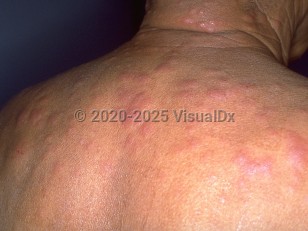Type 1 lepra reaction in Child
Alerts and Notices
Important News & Links
Synopsis

Lepra reactions are acute or subacute inflammatory episodes in leprosy patients, characterized by cutaneous and systemic involvement, caused by a sudden alteration in immune response. These reactions may occur at any time during the course of the disease but most frequently in the first 1-3 years after starting multidrug therapy (MDT). Reactions are responsible for almost all of the acute symptoms arising in association with leprosy. Three types of reactions are identified: type 1 lepra reaction, type 2 lepra reaction, and Lucio phenomenon. Type 1 and type 2 reactions affect 30%-50% of patients with leprosy during the course of the disease.
Type 1 (reversal) reactions are due to changes in cell-mediated immunity (CMI) to the infectious agent Mycobacterium leprae or its antigens. Type 1 reactions occur in the nonpolar forms of leprosy (borderline tuberculoid leprosy [BT], midborderline leprosy [BB], and borderline lepromatous leprosy [BL]) but rarely can occur in lepromatous leprosy (LL) patients after MDT. Starting treatment with MDT is the main risk factor for reversal reaction.
Patients present with increased erythema, edema, and warmth of mostly preexisting skin lesions that become swollen or raised. There is often accompanying edema of the hands and feet. New ulcerations of preexisting lesions may also occur, as well as the formation of new plaques. Additionally, there may be swelling and tenderness of peripheral nerves and loss of sensory or motor neurologic function. Systemic symptoms are uncommon, but cases of severe reaction can be associated with malaise, anorexia, low-grade fever, arthralgia, and myalgia. This reaction may be seen after pregnancy or immunosuppressive treatment. It may also occur in patients co-infected with HIV within months of starting antiretroviral therapy.
Prompt diagnosis and treatment of lepra reactions is necessary to prevent significant neurologic morbidity and disability.
Type 1 leprosy reaction is more common in male patients than in female patients, except during pregnancy, when it has been reported to occur more frequently than in male patients. In general, lepra reactions are rare in children younger than 15 years. Studies report the prevalence of lepra reaction (both type 1 and type 2) in children varies between 1.36% and 8.33%.
Type 1 (reversal) reactions are due to changes in cell-mediated immunity (CMI) to the infectious agent Mycobacterium leprae or its antigens. Type 1 reactions occur in the nonpolar forms of leprosy (borderline tuberculoid leprosy [BT], midborderline leprosy [BB], and borderline lepromatous leprosy [BL]) but rarely can occur in lepromatous leprosy (LL) patients after MDT. Starting treatment with MDT is the main risk factor for reversal reaction.
Patients present with increased erythema, edema, and warmth of mostly preexisting skin lesions that become swollen or raised. There is often accompanying edema of the hands and feet. New ulcerations of preexisting lesions may also occur, as well as the formation of new plaques. Additionally, there may be swelling and tenderness of peripheral nerves and loss of sensory or motor neurologic function. Systemic symptoms are uncommon, but cases of severe reaction can be associated with malaise, anorexia, low-grade fever, arthralgia, and myalgia. This reaction may be seen after pregnancy or immunosuppressive treatment. It may also occur in patients co-infected with HIV within months of starting antiretroviral therapy.
Prompt diagnosis and treatment of lepra reactions is necessary to prevent significant neurologic morbidity and disability.
Type 1 leprosy reaction is more common in male patients than in female patients, except during pregnancy, when it has been reported to occur more frequently than in male patients. In general, lepra reactions are rare in children younger than 15 years. Studies report the prevalence of lepra reaction (both type 1 and type 2) in children varies between 1.36% and 8.33%.
Codes
ICD10CM:
B92 – Sequelae of leprosy
SNOMEDCT:
240407009 – Type 1 lepra reaction
B92 – Sequelae of leprosy
SNOMEDCT:
240407009 – Type 1 lepra reaction
Look For
Subscription Required
Diagnostic Pearls
Subscription Required
Differential Diagnosis & Pitfalls

To perform a comparison, select diagnoses from the classic differential
Subscription Required
Best Tests
Subscription Required
Management Pearls
Subscription Required
Therapy
Subscription Required
References
Subscription Required
Last Reviewed:08/28/2024
Last Updated:09/09/2024
Last Updated:09/09/2024
Type 1 lepra reaction in Child

